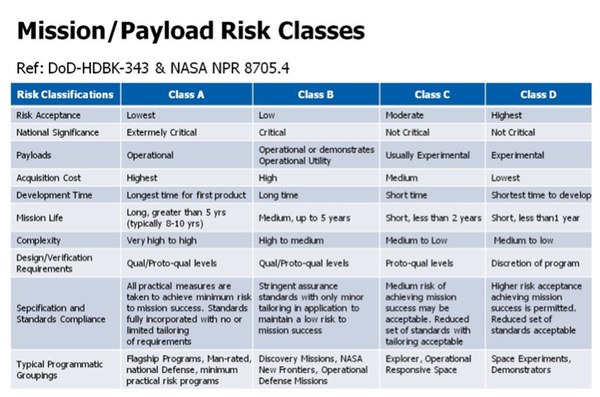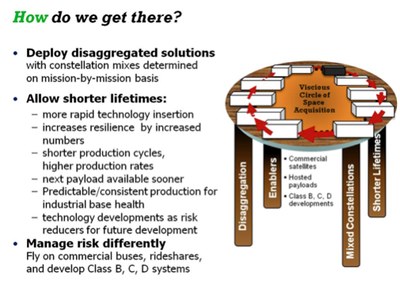Resilient, disaggregated, and mixed constellationsThe origins, development, and operations of the KH-9 HEXAGON reconnaissance satellite<< page 1: so, what would this mean? Class B, C, D developmentThe majority of national security space programs are Class A development programs. As stated earlier, these aggregated produced few highly integrated satellites with little risk tolerance and, due to the resulting high cost, an inability to purchase spares so there would be no rational recovery from a significant failure. Therefore, national security space programs tend to be expensive, require longer life, and more robust performance to mitigate our low risk tolerance. However, all missions have some profile of risk tolerance, from low to high. These then can use Class B, C, or D developments.
Part of the risk equation if we decide to transition to space system architectures that involve shorter lifetimes, shorter development cycles, lower costs, and more risk tolerant systems is that if there is a failure (as in the early days of space) there is always another payload closely following behind, so the impact is not the same as it is today if there is loss of a mission. Some of the pros and cons of pursuing smaller, more affordable Class B/C/D programs rather than Class A developments are:
One way to help with the negative impacts is to empower the AFSPC commander to assess the requirements we have laid on all aspects of our space systems and prioritize them. The commander must also be empowered to develop more responsive, affordable, and predictable architectural options to satisfy these requirements that we currently have. By doing this we will present warfighters with mission-appropriate space capabilities. Rideshares or hosted payloadsAs we are moving to a cost-constrained environment, the US government needs to look at more innovative ways to provide more affordable and timely capability to the warfighter. One such opportunity is to leverage the commercial space business. The commercial space business has built an industry with highly reliable products and a moderate cost. Part of doing this in the commercial space business has been to design and build plug-and-play buses. While this is a concept the Air Force has talked about for years, the volumes of systems purchased, unique requirements laid upon systems, and inability to turn inside a commercial decision loop has left this well of opportunity largely untapped. It certainly would not be difficult to design military payloads to fly on commercial buses. This definitely should be part of any architecture design space in the future. One program leading the way on this concept is Americom Government Services’ Commercially Hosted Infrared Payload (CHIRP). Developed in concert with Orbital Sciences Corporation and Science Applications International Corporation (SAIC), the CHIRP flight development program is designed to reduce risks in the development of wide field-of-view starring infrared sensors, and is being funded by the US Air Force. The program involves the hosting of the sensor on board a commercial communications satellite (on SES-2, a SES World Skies system), a sensor operations center, and a data analysis center. The opportunity presented by flying commercially hosted payloads is tremendous. There are some 200 launches planned to geosynchronous orbit in the next 12 years. Intelsat, Boeing, and SES all have shown an openness to work with the US government on hosted payloads. If only half of these have buses with enough weight and power capacity to accommodate useful payloads, that is still 100 platforms that provide an opportunity to cost-share a bus and the launch scheduled. Commercial providers are interested in participating with the government if the resultant business plan compares equally (in terms of risks and rewards) to other investment options. Employing commercially-hosted architectures, however, will require much more responsiveness in government decision-making, and much shorter and more flexible development timelines. So a necessary goal to use this approach is to institutionalize its aspects, push government and industry to provide agile fast solution to problems, and get the best possible value and capability for the government. And so commercial buses and commercial or other rideshares provide another opportunity to disaggregate, reduce cost, and increase responsiveness for the warfighter.
How would this all apply to needed real world systems? We perform a wide variety of missions in space. Some are more strategically critical and some are subject to more stringent requirements than others; others are less so. This trade space provides an opportunity for engineering a solution. For example, overhead persistent infrared (OPIR) mission capabilities are now provided through an expensive, highly bundled (meaning highly complex and integrated) satellite and ground system solution. These needed OPIR capabilities could be better provided through disaggregated approaches, combining the exquisite systems with more affordable shorter life systems and this, in turn, could increase survivability and risk tolerance for the space acquirers and operators.
Where it makes sense, architectures of mixed constellations of smaller disaggregated satellites and larger, flagship-class exquisite systems could be developed. In such architectures, the use of smaller, more numerous, and more easily produced disaggregated systems would make the overall constellation more resilient if attacked or degraded. Now, we will never remove the need for all exquisite, complex space systems, but complementing these with disaggregated systems could be a cost-effective answer to our ability to assure a healthy industry and assure our warfighters that space capabilities will be there when they are needed. A mixed system could also leverage the use of payloads with smaller, more affordable Class B/C/D approaches, by flying them on dedicated commercial buses or as rideshares on commercial or military buses, reducing costs even more. Of course, data produced by disaggregated systems can be aggregated on the ground. Designing disaggregated systems with open data architectures can enable improved use data sharing as these systems get built, deployed, and operated. This is a very smart idea, and certainly consistent with principles advocated by network-centric operations proponents. If one can balance risk with cost, adaptability, and resilience, and agree to reduce mission lifetime requirements, and then combine these strategies with disaggregated or mixed constellation approaches, this will provide a number of important benefits:
Moving forwardHere is what we can do to boldly move forward on these recommendations:
Concluding thoughtsWe are at a seminal moment in the future of space. Budgets are going down: of that there is no doubt. And warfighters need and want more and more capabilities from space: of that there is unequivocally no doubt. That conundrum requires that we change how we acquire, operate, and sustain our space systems. The question is, how should we shape this change? We need to change the assumptions for our space enterprise and forge different business models with different logic and inherent costs and resulting in different mission architectures. This change will bring different risks. We must start thinking in a way that allows us to identify, handle, and defeat programmatic risks and challenges. In doing this, our understanding of what constitutes unacceptable risk must evolve, and be balanced with cost, adaptability, technology insertion, and resilience. Indeed, such risk is clearly in the “eye of the beholder”. Given the financial challenges our country is facing, the level of what can be considered acceptable risk must change. Accordingly, the risk presented by disaggregated/mixed constellation acquisition models is acceptable, and should be wholly considered. Home |
|

